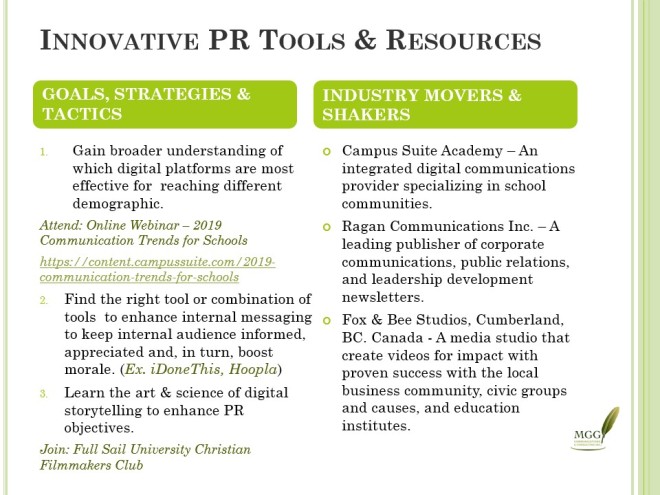Protecting a brand name through internal management strategies is perhaps my strongest area as a communicator. Having studied Organizational Behaviour during my undergrad studies, I have been keenly interested in how leaders motivate employees to be brand ambassadors. Anyone who has studied Business and has had the good fortune of reading In Search of Excellence can attest, a good reputation begins on the inside.
Positioning an organization or an individual positively in the face of adversity with a proactive strategy is what I do best. As a young Public Affairs Officer, I cut my teeth on crisis communications during two extremely significant crises, the first a Canadian Forces Snowbird jet crash followed three months later by 9/11. Yet, as I progress through my career as a P.R. practitioner I am discovering another kind of crisis unfolding, which was emphasized in this month’s course, Reputation Mangement Strategies. It’s happening every day, often right under the noses of senior executives. I am talking about the erosion of brand reputation at the hands of staff and their poor customer care and service. Is it a lack of training, company ethics, the enabling power of social media that allows the consumer to rant or even embellish a complaint, or a combination of all of the above?
Go ahead, say it with me. “Serendipity!” The one common thread that weaves through my mastery journey has been this uncanny alignment of a situation that mysteriously occurs to reinforce my learning for each month’s course of study. August kicked off with a terrible hotel stay at the Best Western Dorchester in Nanaimo, B.C. A terribly inexperienced hotel receptionist made a gross error of assigning my family to a room that was already occupied, among other slip-ups. Disappointed in the experience, I felt compelled to leave a review on Trip Advisor, Google+ and Booking.com suggesting the hotel chain invest in quality customer care training if it truly valued its brand name in the hospitality industry. But that was not the learning. The learning came when I received an apologetic email from a member of the executive staff of the hotel chain offering gratitude for my sage advice. The response demonstrated that corporate staff does pay attention to brand reviews, which was a key lesson highlighted in Week 2.
August was also the month I took advantage of public transit and, to my delight, found it not only convenient but rather inspiring. In my community, BC Transit has mastered the art of customer relations on the frontline, with the bus drivers. Each driver I encountered has greeted me enthusiastically and engaged in casual conversation as commuters pop on and off the bus. There is a real sense of community. Conversations take place on our buses and often when I am riding, I will initiate a dialogue with a fellow rider. Relations with the public is what we practitioners do best. This leads me to my next point about engaging with constituents.
During Week Four I encountered negative sentiment from a student’s family member about my client’s on a community Facebook page. Had it not been for the keen eye of the staff who picked up on the rant the comments may have gone unnoticed because there were no direct mentions of the school district. Fortunately, I had recently created an infographic based on the United States Air Force Social Media Response Plan and put our uniquely tailored flowchart to good use. The correct reaction was to respond quickly and take the conversation offline, as recommended by Social Media Examiner, inviting the parent to engage in a dialogue with the school board about the situation. A dialogue did indeed occur and while a resolution is in the works, the individual posted again to the lengthy and very inaccurate conversation she had initiated from her complaint that the matter was being handled. The conversation suddenly ended. Now I ask, how hard was that?
Creating dialogue to establish relationships also presents an opportunity to learn something from the other individual or organization that you might not have previously known and provides each party to the dialogue a new perspective or richer understanding of a situation or decision. Turning to social media to voice one’s perspective without taking the time to gather correct information hinders positive relations. Negative electronic word of mouth can lead to an erosion of trust and the spread of misinformation and “have a negative impact on consumers’ evaluations of brands (van Noort. G. and Willemsen, 2012). My goal in this situation was to ensure the individual was not misled or become so distraught we would not gain her trust and confidence. The second goal was to educate the rest of the community without proactively engaging on social media as that could potentially go south fast and interpreted as being defensive, according to Jay Cooper of Campus Suite. To combat misinformation, a press release was drafted, shared with the media and online with a similar message embedded in a welcome back video created for Comox Valley Schools.
Brand management is a never-ending task but need not be daunting. Going back to the experience on the bus, this month I also learned and appreciated how important it is to engage with constituents positively. Yet, until society recognizes the potential to solve matters without social media (that’s a whole topic onto itself), organizations will always have to be vigilant and scan the online environment for a potential crisis and be prepared to respond.
References
Cooper, J. (2018, September 6). How to handle negative comments on school social media. Retrieved from http://bit.ly/CampusSuite_HandleNegativeComments
Grant, M. (2019, July 9). 10 reasons to have a social media response triage flowchart. Retrieved from https://www.socialfish.org/10-reasons-to-have-a-social-media-response-triage-flowchart-2/
Shuckle, R. (2015, December 2015) How to handle customer complaints via social media. Retrieved from https://www.socialmediaexaminer.com/how-to-handle-customer-complaints-via-social-media/
van Noort. G. and Willemsen L. (2012, August). Online damage control: The effects of proactive versus reactive webcare interventions in consumer-generated and brand-generated platforms. Journal of Interactive Marketing. Vol. 26 Issue 3. Retrieved from https://www.sciencedirect.com/science/article/pii/S1094996811000600




